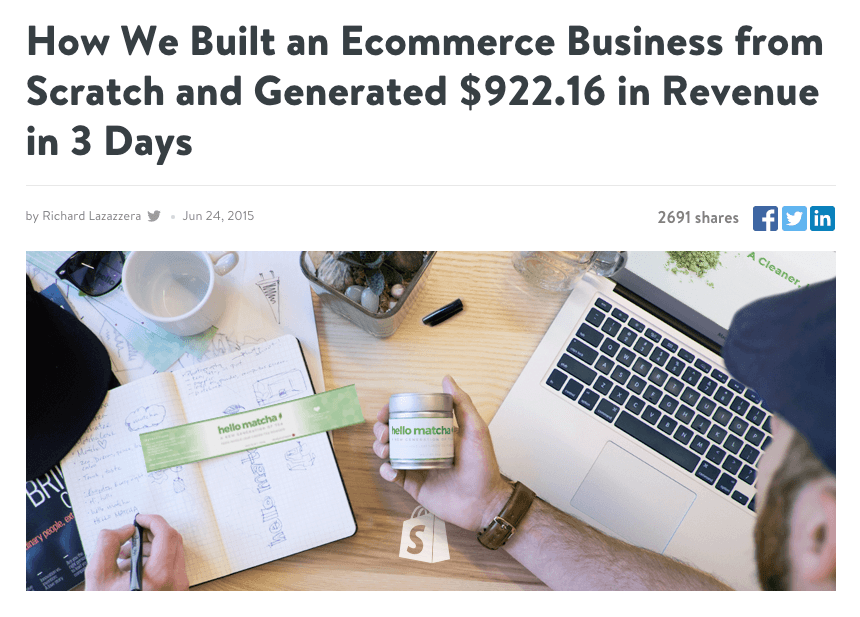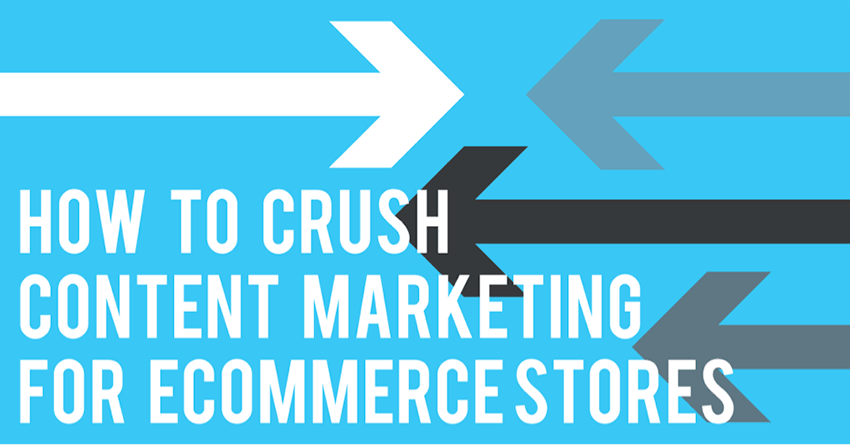Last week, a long lost relative called me.
He’d heard I make a living selling things online, and he’s just about to start his own internet-based business.
The things I said during the call are the same things I say to anyone who approaches me looking for a little advice. I thought it would be helpful to write everything down, so in the future, I can direct people to this post instead!
Unless you’re Jeff Bezos and can afford to hire the best designers, the best developers, and the best marketers in the world, getting started in ecommerce will require you to get your hands a little dirty. You’ll also need to be willing to learn as you go – you’ll be in charge of everything from the outset.
Selling things online is a lot harder than people tend to think, but if done right, getting started in ecommerce can lead you to huge financial rewards. This guide will cover the bases of getting yourself up and running.
Find your niche
Often people approach ecommerce with a niche in mind – if that’s your plan, great! This is the best way to set out.
If you have experience working in a specific industry or area then it makes sense to transfer your expertise and knowledge of that niche to your ecommerce business.
Although it’s possible to identify a niche and become an expert in it, I generally wouldn’t recommend doing that (even though that’s what I did).
It often feels like you’re trying to reinvent the wheel trying to learn the nuances of an unfamiliar industry, while also figuring out how to compete with established players looking to eliminate you as competition.
Source your goods
Sourcing goods / product procurement can be a real headache. Fortunately, I wrote a detailed guide to product procurement, just for you! ☺
You have to strike the correct balance between cost and quality, and deciding which end of the market you’re going to cater to is a challenge.
Typically you can’t cater for the entire market due to prohibitive start-up costs – so finding your niche within a bigger market is something that has to be done.
Once you know which end of the market you’re aiming for, you can procure goods. If you’re going to the lower end, you may decide to import goods by the container load from Asia. If you’re going to cater for the higher end of the market, you’ll probably end up sourcing from established, trusted brands domestically.
Don’t forget that a lot of established brands and suppliers insist that you have a “brick and mortar” store before allowing you to open an account. Check that such restrictions won’t impede your plans before progressing with your idea.
Very, very, very rarely will suppliers flock to work with you. Before you spend lots of time and money on developing your ecommerce business, make sure you can actually source the products you plan to sell.
Count the cost
After finding your niche and liaising with suppliers, you need to seriously count the cost.
Can you afford to buy inventory? If so, how much inventory can you afford to hold?
Will you need to dropship instead?
It’s important to count the costs at this stage and be realistic about things – because your ecommerce journey gets a whole lot more expensive when we start looking at websites and online marketing. Be super honest with yourself – can you really afford to make an entrance in this niche, steal market share from your competitors, pay your wages and make a profit?
If the answer is “no” then some serious questions have to be raised before you go any further.
Buy a domain name
When you’re set on a niche, you’ve found a supplier to work with, and you’ve established that costs are manageable; it’s time to buy a domain name.
Don’t just search for any old name that’s free to register for $10, take time to seriously think about the name you’re going to use.
If everything goes well, it’ll be this name that people see advertised during the Super Bowl. It’ll be the name on everyone’s lips – so make it a name you’re proud to represent.
Brand names and domain names aren’t really the same thing, but in a world of digital devices and distractions, you can see the logic behind making your domain name your brand name – and vice versa.
So, like I just said, don’t go and buy a $10 domain because it’s cheap (nicksamazingcarpets.com, for example). Take a long, composed look at what’s available to register – and what’s available on the aftermarket. A few thousand dollars spent on a quality domain name can save you hundreds of thousands of dollars on marketing later down the line. Sites like Sedo and DomainNameSales are a good place to see exactly what’s available on the domain aftermarket, and at what prices.
Design & develop a website
The next step is to have a website designed and developed. At this stage, there are various corners you can cut – for example there’s no need to spend thousands of dollars on a unique design and bespoke CMS.
Instead, you can spend less than $100 on a readymade template, and use a hosted CMS like Bigcommerce or Shopify. Don’t go crazy at this stage. Just get something online that’s fairly pretty, and use that web presence to validate your ecommerce idea.
If it works then great, if not, you haven’t wasted a fortune on a website that you can’t make a profit with.
To put this into context, I recently launched a website for less than $100, all-in. That website surpassed the $15,000 turnover mark last week, so anyone who says your site needs to be perfect from day one isn’t being honest.
We’re actually still rocking a fairly horrible design – but now we’ve validated the idea I have no problem signing off a five figure budget for a professional design and build.
Add your products and pages
A fancy website design is nothing without content. Don’t neglect the importance of properly adding products and pages (Contact Us, About Us, Terms & Conditions, etc.) to your website.
Take time to properly write product descriptions and engage a lawyer to write legally compliant terms and conditions that cover you, and your customers.
It also pays to have professional product shots produced (if your manufacturer doesn’t supply them.). After all, a picture’s worth a thousand words – or so the old saying goes!
Can’t afford a professional photog? No problem, we’ve got you covered with a great guide to taking product photos like a pro.
Launch
The day you launch your ecommerce website won’t be filled with fireworks and champagne. In fact, it’ll just be a normal day, except you’ll feel a little bit excited inside and properly a bit nervous as well.
This is where the hard work really begins, because you won’t make any sales on your sparkly new website without advertising it first (except from your mom).
Don’t feel disheartened if you don’t make your first sale on launch day – or even during the first week after launch. It can take a good month or so before traffic starts hitting your site and those sales come rolling in.
Market like crazy
Shopping feeds, social media, word of mouth, paid clicks, email campaigns, blogger reviews, vlogger reviews and flyers are just a few ways to market your website.
Some sites are easier to advertise than others; just know that in my experience, at least 50% of your time should be spent marketing in those early days.
While some people opt for expensive marketing agencies (if that’s in your budget), I think it’s better to get your hands dirty and start marketing yourself. After all, you understand the products you’re selling far better than any employee at a marketing firm.
Detailed product knowledge allows you to create and develop marketing campaigns that resonate with customers, campaigns that hit the spot every time. When marketing hits the spot, sales are made!
Some people will tell you “PPC is a rip off” or “shopping feeds don’t work” – don’t listen to them! I haven’t yet come across an ecommerce business where it wasn’t possible to make PPC and shopping feeds profitable with a little tweaking and testing.
Keep calm and carry on
It takes months – even years – to see traction with an ecommerce website. The important thing to remember is that if you do things right, success will come.

Ecommerce is a tough world to enter – no matter what niche you choose. Only the fittest companies survive, so strive to make your store is well-executed in every respect.
For a real-world example of great execution on these concepts, check out this awesome post from the Shopify team on starting an ecommerce business in 3 days.
Have other thoughts on getting started in ecommerce? Share them with us below!










9 thoughts on “Your Guide To Getting Started In Ecommerce”
Great tips suggested for starting an online business. Intoday’s digital world it’s quite essential get our business presence onlin. Nice post thank you for sharing.
Ragavi Roy
Ecbilla
Thanks for the comment Ragavi. I gotta ask though, how did you get my picture??! haha
Don’t know Mike, It’s coming default I guess.
Great tips suggested for starting an online business. Intoday’s digital world it’s quite essential get our business presence onlin. Nice post thank you for sharing.
Ragavi Roy
Ecbilla
Thanks for the comment Ragavi. I gotta ask though, how did you get my picture??! haha
Don’t know Mike, It’s coming default I guess.
Great tips suggested for starting an online business. Intoday’s digital world it’s quite essential get our business presence onlin. Nice post thank you for sharing.
Ragavi Roy
Ecbilla
Thanks for the comment Ragavi. I gotta ask though, how did you get my picture??! haha
Don’t know Mike, It’s coming default I guess.